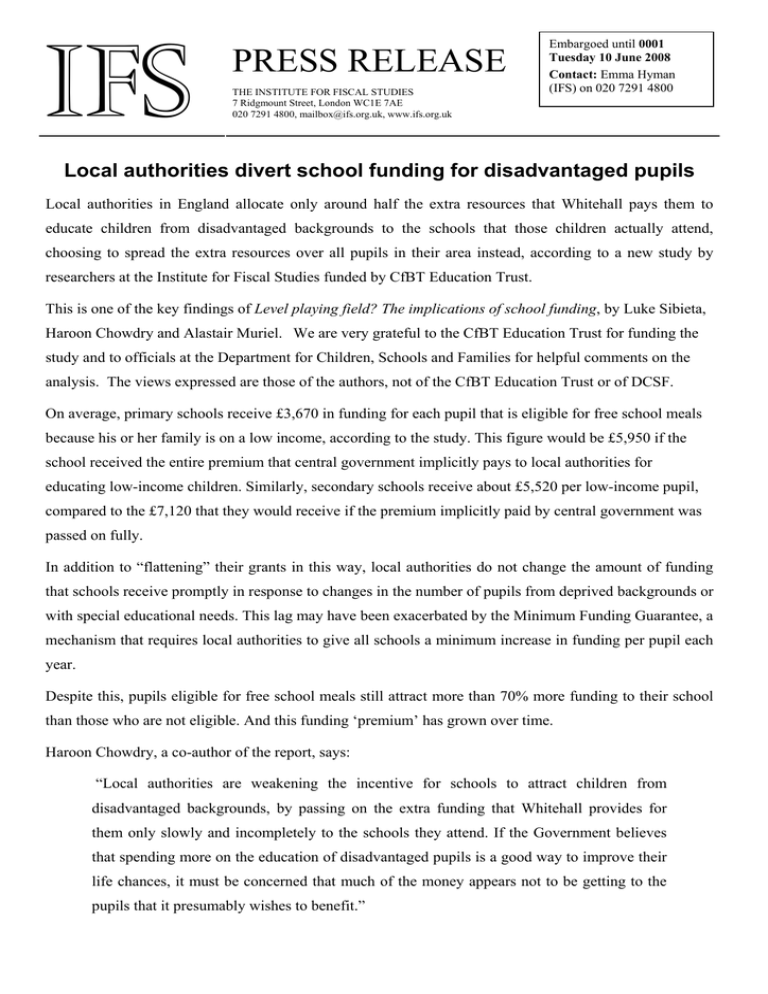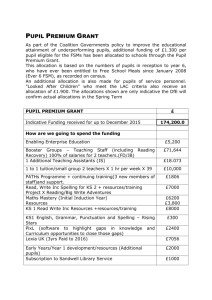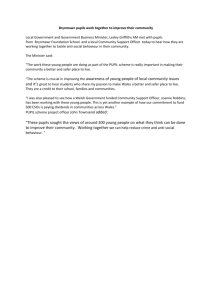IFS PRESS RELEASE
advertisement

IFS PRESS RELEASE THE INSTITUTE FOR FISCAL STUDIES 7 Ridgmount Street, London WC1E 7AE 020 7291 4800, mailbox@ifs.org.uk, www.ifs.org.uk Embargoed until 0001 Tuesday 10 June 2008 Contact: Emma Hyman (IFS) on 020 7291 4800 Local authorities divert school funding for disadvantaged pupils Local authorities in England allocate only around half the extra resources that Whitehall pays them to educate children from disadvantaged backgrounds to the schools that those children actually attend, choosing to spread the extra resources over all pupils in their area instead, according to a new study by researchers at the Institute for Fiscal Studies funded by CfBT Education Trust. This is one of the key findings of Level playing field? The implications of school funding, by Luke Sibieta, Haroon Chowdry and Alastair Muriel. We are very grateful to the CfBT Education Trust for funding the study and to officials at the Department for Children, Schools and Families for helpful comments on the analysis. The views expressed are those of the authors, not of the CfBT Education Trust or of DCSF. On average, primary schools receive £3,670 in funding for each pupil that is eligible for free school meals because his or her family is on a low income, according to the study. This figure would be £5,950 if the school received the entire premium that central government implicitly pays to local authorities for educating low-income children. Similarly, secondary schools receive about £5,520 per low-income pupil, compared to the £7,120 that they would receive if the premium implicitly paid by central government was passed on fully. In addition to “flattening” their grants in this way, local authorities do not change the amount of funding that schools receive promptly in response to changes in the number of pupils from deprived backgrounds or with special educational needs. This lag may have been exacerbated by the Minimum Funding Guarantee, a mechanism that requires local authorities to give all schools a minimum increase in funding per pupil each year. Despite this, pupils eligible for free school meals still attract more than 70% more funding to their school than those who are not eligible. And this funding ‘premium’ has grown over time. Haroon Chowdry, a co-author of the report, says: “Local authorities are weakening the incentive for schools to attract children from disadvantaged backgrounds, by passing on the extra funding that Whitehall provides for them only slowly and incompletely to the schools they attend. If the Government believes that spending more on the education of disadvantaged pupils is a good way to improve their life chances, it must be concerned that much of the money appears not to be getting to the pupils that it presumably wishes to benefit.” Most school funding ‘follows the pupil’ in the English system, with the allocation of resources directly determined by pupil numbers (weighted by age and background). However, the current system does not live up to the ‘school choice’ programme enthusiastically described in the 2005 White Paper, in which successful schools expand, new entrants compete with existing providers, and weaker schools either improve their performance or else contract and close. Proponents of such schemes argue that they would create strong incentives for all schools to put effort into maintaining and improving their performance. Rigidities elsewhere in the school system blunt the incentives created by parental choice. Of the three criteria often used to determine whether genuine ‘school choice’ exists (pupil-led funding, supply flexibility and management freedom), the English system probably ‘fails’ on the last two. The supply side appears largely inflexible, with little threat of entry from new providers. New school entry is decided by local authorities, who are placed under pressure from both the Government and the Audit Commission to keep surplus places to a minimum. This leaves them with little incentive to encourage new schools to open and to compete for pupils with existing schools. School management is constrained by binding collective agreements covering many aspects of school operations, including pay and conditions. Ali Muriel, IFS Researcher and co-author of the report, says: “In a system of inflexible supply, parent demand is not harnessed as a force to drive up standards – instead, securing places at the best performing schools is a zero sum game, and one which better-off parents tend to ‘win’ at the expense of the less well-off. In other words, if schools do not have to compete with one another, then parents are forced to. The English system clearly illustrates that pupil-led funding does not by itself create positive incentives for schools to improve.” The present school funding system is also complex and poorly understood. Luke Sibieta, IFS Researcher and co-author of the report, says: “Just as a complicated tax system may blunt incentives to work hard or invest money, a complex school-funding system may make the incentives to attract pupils from different backgrounds so opaque that schools ignore them. It would be better to have a simpler and more transparent system, where the level of extra funding for pupils from differing backgrounds is easier to identify. This would allow a better informed debate over the appropriate level of support and could simultaneously promote equity and encourage schools to up their game.” The study also notes that education spending in the UK has seen increases averaging 4.3% a year in real terms over the past ten years, with particularly large increases over Labour’s second term of office. However, this rate of increase will slow to 3.4% a year over the period covered by the 2007 Comprehensive Spending Review (2008-09 to 2010-11). School spending in England has enjoyed larger increases than education as a whole over the past ten years (averaging 6.0% per year in real terms), with particularly large increases in schools’ capital spending. School spending per pupil has increased by 6.4% a year in real terms under Labour to date, compared to increases averaging 4.7% in the independent sector. As a result, state spending per pupil has risen from 50% of the private-sector level in 1997-98 to 58% in 2006-07. Gordon Brown promised in Budget 2006 to increase state-school spending per pupil to the level seen in the private sector in 2005-06, but there is no timescale attached to this pledge. Even if there were, it would not guarantee a further narrowing of the contemporaneous gap between spending in the state and independent sectors. ENDS Notes to editors: 1. CfBT Education Trust is a not-for-profit education consultancy and service organisation (www.cfbt.com) Its object is to provide education for public benefit both in the UK and internationally. Established 40 years ago CfBT Education Trust now has an annual turnover exceeding £100 million and employs more than 2,000 staff worldwide who support educational reform, teach, advise, research and train. CfBT commits around £1 million every year to practicebased educational research. This report follows a previous CfBT-funded study, Costs and Diversity in Schools: An International Review by Nick Burnett. For further information, please contact Lindsay Blamires, Marketing Communications Officer, on 0118 902 1841 or LBlamires@cfbt.com 2. Further analysis will be available in Level playing field? The implications of school funding by Luke Sibieta, Haroon Chowdry and Alastair Muriel. This work was funded by the CfBT Education Trust. This publication will be published on Tuesday 10 June 2008; for advance press copies please contact Bonnie Brimstone or Emma Hyman on 020 7291 4800. 3. This report will be launched on Tuesday 10 June 2008. The briefing will start at 1pm and is expected to conclude by 2.45pm. If you would like to attend, please contact Bonnie Brimstone (020 7291 4800 or bonnie_b@ifs.org.uk).






